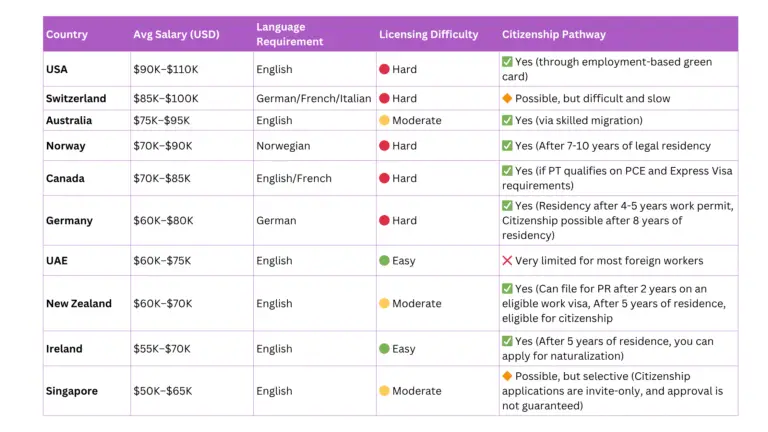Top 10 Countries with the Highest Physical Therapist Salaries Worldwide (2025)
The global demand for physical therapists (PTs) is stronger than ever. With aging populations, increased awareness of rehabilitation, and the rise of fitness and sports therapy, PTs play a vital role in modern healthcare. But for professionals considering work overseas, one key factor is salary.
In this blog, we rank the top 10 countries with the highest average physical therapist salary in 2025, based on the most recent available data from Indeed and other reputable salary aggregators. All salary figures are in US dollars (USD).
Methodology: How Were PT Salaries Compared?
This list considers:
- Average gross annual salary in USD (converted where necessary)
- Data primarily from Indeed, Glassdoor and local government sites*
- Additional consideration for taxation, living costs, and ease of licensure for foreign PTs

1. Physical Therapist Salary in United States
Average Salary (USD): $93,000 – $110,000
Source: Indeed USA (2025)
Top states: California, Nevada, New Jersey, Alaska
The U.S. leads the world in physical therapy compensation. The Bureau of Labor Statistics and Indeed data show PTs consistently earn high salaries, especially in private clinics, hospitals, and home healthcare.
It is important to note though that for foreign physical therapists, salary may vary due to several factors like State assignment, employment type if direct hire or staffing agency and prevailing wage determination (PWD) for immigrants and Labor Condition Application (LCA) if you are entering United States under an H1-B Visa path.
Pros: Permanent Residency Visa and Citizenship pathways for foreign-educated physical therapists, high salary potential, career growth, specialization
Cons: Expensive licensing and longer visa processing timeline
2. Physical Therapist Salary in Switzerland
Average Salary (USD): $88,000 – $102,000
Source: SalaryExpert / Glassdoor (2025)
Second on our list is Switzerland. It’s strong healthcare system and high living standards are reflected in PT salaries. However, working here usually requires proficiency in one of the national languages (German, French, or Italian) and a recognition process for foreign credentials.
Pros: High salary, modern facilities
Cons: Language requirement, high living cost

3. Physiotherapist Salary in Australia
Average Salary (USD): $75,000 – $90,000
Source: Indeed Australia
Australia offers good wages for Physiotherapists, especially in metropolitan areas and private practices. With a straightforward licensing process through the Australian Physiotherapy Council (APC), foreign-trained PTs have a realistic pathway to practice.
Sad news is, for foreign educated Physical Therapists aspiring to work in Australia, most of the Skilled Visa pathway options are based on point-system with several factors to weigh in like fluency in English, number of years of work experience as a Physical Therapist as well as the education level obtained for Physical Therapy and other specialization.
Your chances of getting higher points relays on the years of experience you have or your proficiency in English.
Pros: English-speaking, good work-life balance
Cons: Licensing takes time (APC + Ahpra registration) + Point based Visa System
4. Physical Therapist Salary in Norway
Average Salary (USD): $72,000 – $90,000
Source: SalaryExplorer / Nordic data (2025)
Norwegian PTs earn high salaries and benefit from generous public healthcare funding. While Norway values foreign professionals, you must meet strict language (Norwegian) and credential requirements to practice.
Pros: Excellent healthcare system
Cons: Learning the language is essential

5. Canada Salary for Physical Therapists
Average Salary (USD): $70,000 – $85,000
Source: Indeed Canada
Physical Therapists in Canada earn competitive wages, particularly in British Columbia and Ontario. The country also offers a fair and structured credentialing process via the Canadian Alliance of Physiotherapy Regulators (CAPR). The PCE exam is required for foreign-educated physiotherapists.
Though Canada recently opened it’s Express Visa with PT being included as one of the skilled occupations to qualify, many foreign PTs fail to pass their Canadian Physiotherapy Competency Exam within the first and second attempt.
Pros: Friendly immigration system
Cons: Long licensing timeline for foreign-trained PTs and low PCE success rate
6. Physiotherapist Salary in Germany
Average Salary (USD): $65,000 – $80,000
Source: Glassdoor Germany
Top 6 on our list is Germany — it is one of the most attractive countries especially to Physiotherapists who are looking for quality of life and a taste of different culture other than America and Australia.
Germany values PTs in both the private and public sectors. Salaries are attractive, especially relative to cost of living in mid-size cities. However, foreign PTs must translate qualifications and pass a German language test (usually B2 level).
Pros: Strong labor protections, high demand
Cons: Language and paperwork requirements can be challenging

7. Salary of Physical Therapists in United Arab Emirates (UAE)
Average Salary (USD): $60,000 – $75,000 (tax-free)
Source: Indeed UAE
The UAE offers tax-free salaries and is a popular destination for expatriate healthcare workers. Dubai and Abu Dhabi have high demand for English-speaking PTs in hospitals, sports clinics, and wellness centers.
Despite the attractive tax-free salary environment, for foreign Physical Therapists aspiring to have their citizenship or looking forward to retiring in a foreign country might be impossible.
Currently, even though a long-term residency visa is available, UAE does not offer citizenship to foreign PTs.
Pros: No income tax, English widely used
Cons: Licensing with HAAD/DHA/MOH required. No citizenship pathway
8. New Zealand Physiotherapist's Salary
Average Salary (USD): $60,000 – $70,000
Source: Indeed NZ / Careers.govt.nz
With its welcoming immigration policies and need for healthcare workers in regional areas, New Zealand is a great destination for PTs. English-speaking therapists with solid clinical experience can navigate licensure via the Physiotherapy Board of New Zealand.
Pros: English-speaking, high quality of life
Cons: Smaller job market
9. Physical Therapist Salary in Ireland
Average Salary (USD): $58,000 – $70,000
Source: Indeed Ireland
Ireland’s healthcare system is expanding, especially with a focus on allied health. Foreign-trained PTs can register through CORU. Ireland is an appealing location due to its culture, language, and ties to both the EU and English-speaking world.
Pros: English-speaking, less competitive than UK
Cons: Urban living is expensive
10. PT Salary in Singapore
Average Salary (USD): $55,000 – $65,000
Source: Indeed Singapore
Singapore’s emphasis on preventive care and medical tourism has boosted demand for skilled PTs. While salaries aren’t as high as in the West, the low tax rate and modern infrastructure are big draws.
Pros: English-speaking, clean and safe city
Cons: Limited public sector job opportunities for foreigners
Physical Therapist Salary Comparison Table Worldwide

Conclusion: Is High Salary Everything?
While salary is a strong motivator, PTs should consider:
Cost of living (e.g., $100K in NYC ≠ $100K in Berlin)
Work culture and job satisfaction
Immigration requirements
Family lifestyle and safety
If you’re a physical therapist looking to work abroad, start early with researching licensing pathways, verifying your credentials, and improving language skills (if needed).
Read more helpful articles about physical therapy jobs abroad here.



